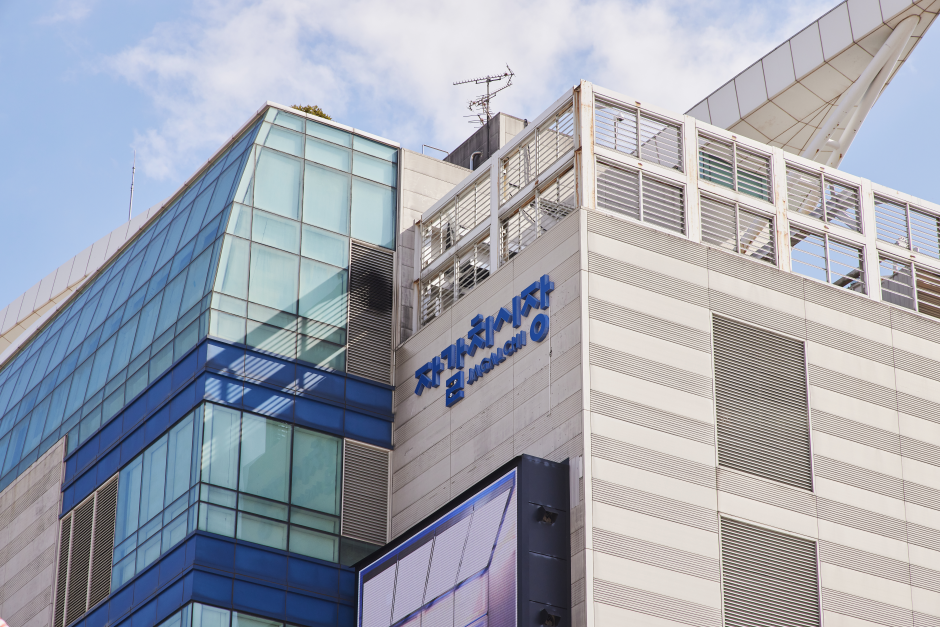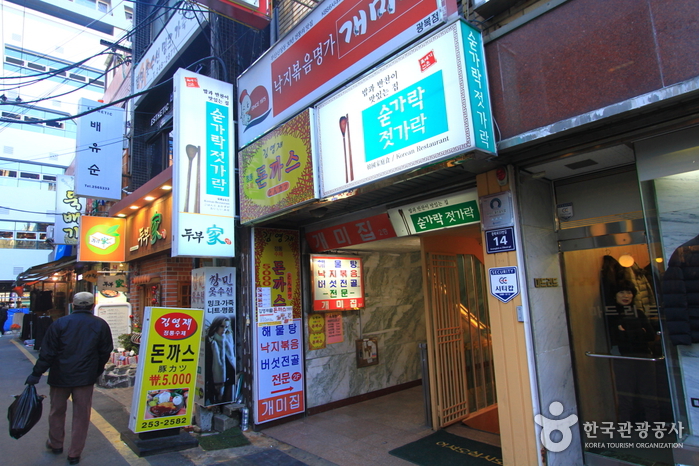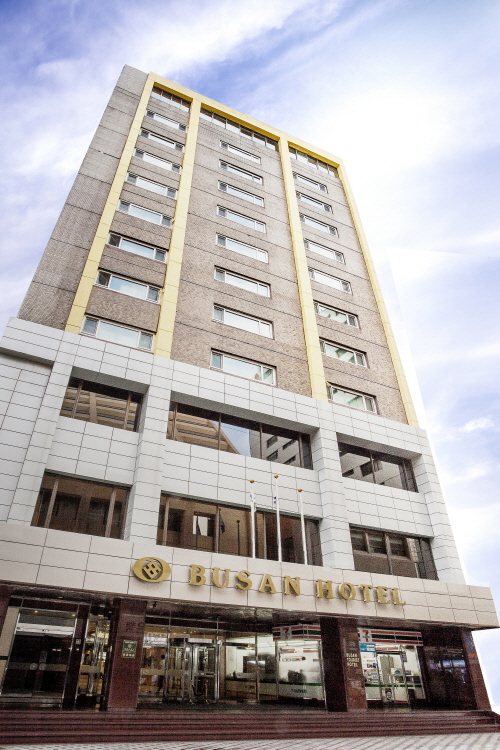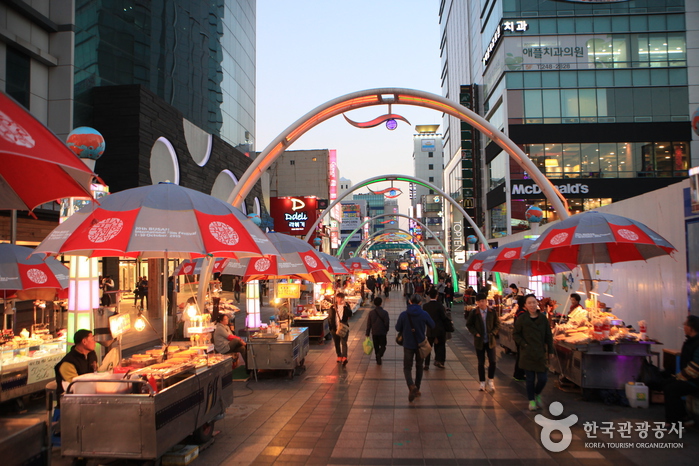Hotel Forêt Premier Nampo [Korea Quality] / 호텔포레 프리미어 남포 [한국관광 품질인증/Korea Quality]
246.0796894733716m 1 2021-03-27
54-1, Gudeok-ro, Jung-gu, Busan
+82-51-242-2200
This hotel is located in the midpoint between Jagalchi Station and Nampo Station of Busan Metro Line 1. It takes about 6 min by foot to reach either of the stations, and a large number of bus stops near the hotel offers good accessibility. There are five types of rooms in Hotel Forêt Premier Nampo, from Standard to Suite. All rooms are furnished with a calm and understated interior with wooden or low-saturation color furniture acting as keystones. Air purifier, bidet, and premium duck down bedding offer pleasant conditions for sleeping. Rooms face different directions, but all offer a great view of Busan’s city center. Yongdusan Park can be seen from the Standard Twin rooms; Busan city center and Namhangdaegyo Bridge from the Deluxe Double; and Namhangdaegyo Bridge and the sea beyond from the Suite. Facilities also live up to the hotel’s reputation, with a cafe spanning the 1st and 2nd floor of the hotel and a restaurant on the third floor. Business travelers can also make use of the hotel’s business center and conference rooms. Gukje Market, Jagalchi Market, and Yongdusan Park are reachable by foot.
Yongdusan Jagalchi Special Tourist Zone (용두산 자갈치 관광특구)
247.59775530786888m 13596 2021-03-11
52, Jagalchihaean-ro, Jung-gu, Busan
+82-51-600-4000
Yongdusan Jagalchi Special Tourist Zone is an attractive tourism area embracing history and culture. Vendors in the traditional market welcome tourists with their warm hearts, selling their famous street food such as rice cake, ssiat hotteok (sugar-filled seeded griddlecake), bibim dangmyeon (spicy glass noodles), pat juk (red bean porridge), and pat bingsu (shaved ice with sweetened red beans). Bosu-dong and 40-Step Culture & Tourism Themed Street also show the history of each street to people traveling in the area. Including Yongdusan Park, the special tourist zone includes traditional markets like Jagalchi Market, Gukje Market, and Bupyeong Market, and historical cultural resources like Yeongdodaegyo Bridge, Bosu Book Street, and Busan Modern History Museum. The restoration of Yeongdodaegyo Bridge in November 2013 has created a unique sightseeing attraction that is hard to see in other regions and has emerged as a new famous spot. Bupyeong (Kkongtong) Market and Gukje Market are also special markets full of things to see. Various festivals including Busan International Film Festival, Busan Jagalchi Festival, and Busan Christmas Tree Festival are held for all kinds of visitors. The view from Yongdusan Park and fresh seafood from Jagalchi Market, as well as peaceful strolling at Bosu Book Street and 40-Steps make a trip to Busan memorable and happy.
Current State of Yongdusan and Jagalchi Special Tourist Zone
1) Districts Covered: Areas around Gwangbok, Nampo and Bupyeong-dong, parts of Donggwang, Daecheong, Bosu and Jungang-dong, Busan
2) Total Area: 1,079,836 ㎡
3) Designated on May 14, 2008
* Tourist Attractions
Yongdusan Park, Yeongdodaegyo Bridge, Jagalchi Market, Gukje Market, Bupyeong Market, Bosu Book Street, etc.
Jagalchi Market (부산 자갈치시장)
248.56132516081405m 139109 2024-01-05
52 Jagalchihaean-ro, Jung-gu, Busan
Jagalchi Market, located on the seaside road in Busan's Jung-gu, is Korea's largest seafood market, selling both live and dried fish. After the Korean War, the market solidified itself as a fish market. Most of the people who sell fish are women, so the vendors here are called Jagalchi Ajumeoni, "ajumeoni" meaning middle-aged or married woman in Korean.
This market represents Busan and is famous throughout the country. Visitors can eat fresh raw fish right at the market. Even nowadays visitors can see women selling mackerel, sea squirts (ascidians) and other seafoods on wooden boxes along the road outside of the market and along the shore.
Nature Collection - Nampo Branch [Tax Refund Shop] (네이처컬렉션 남포)
257.6876685846482m 0 2024-04-23
2F Lotte Outlet Gwanggyo Branch, 10, Docheong-ro, Yeongtong-gu, Suwon-si, Gyeonggi-do
-
Sutgarakjeotgarak (숟가락젓가락)
278.7384999023515m 21175 2020-08-12
14, Gwangbok-ro 55beon-gil, Jung-gu, Busan
+82-51-248-0132
Sutgarakjeotgarak serves traditional home-made tofu dishes, made with soy beans grown in Korea.
New Year's Bell-ringing Ceremony (새해맞이 시민의 종 타종행사)
294.1296449271107m 29433 2020-03-25
37-55, Yongdusan-gil, Jung-gu, Busan
• 1330 Travel Hotline: +82-2-1330 (Korean, English, Japanese, Chinese) • For more info: +82-51-501-6051
The New Year's Bell-ringing Ceremony in Busan is an event for local residents and tourists to wrap up the end of the year and greet a new year. It is a representative winter themed festival of Busan, held December 31 to January 1.
Lloyd - Gwangbok Branch [Tax Refund Shop] (로이드 광복)
295.5101280563038m 0 2024-04-18
40, Gwangbok-ro, Jung-gu, Busan
-
Busan Tourist Hotel (부산관광호텔)
296.2078976590518m 20441 2021-07-22
23, Gwangbok-ro 97beon-gil, Jung-gu, Busan
+82-51-241-4301
Busan Tourist Hotel, opened on September 11, 1974, has proudly served travelers to the Busan area for over 40 years. Located by Yongdusan Park, Gukje Market, and Jagalchi Market, the hotel is convenient for travelers using but Busan Port Passenger terminal.
BIFF Square (BIFF 광장)
298.48305583309445m 145689 2024-04-26
4 Nampo-gil, Jung-gu, Busan
+82-1688-3010
Busan’s modern movie district was originally little more than a pair of cinemas that were built following Korea’s liberation from Japanese colonial rule over half a century ago. However, major renovations took place ahead of the first Busan International Film Festival (BIFF), and the newly transformed district was named BIFF Square on August 14, 1996.
Having been remade into a cultural tourist attraction promoting the advancement of Korea’s film industry, BIFF Square has contributed to Busan’s newfound status as an international cultural tourist city. The 428 meter-long street stretching from the Buyeong Theater in Nampo-dong to the overpass in Chungmu-dong was divided into “Star Street” and “Festival Street,” and on the eve of the festival each year the “BIFF Square Ground Opening” is held here. During the ceremony, events such as the hand printing of famous movie celebrities and Nunkkot Jeomdeung (snow-flower lighting) take place. A district such as BIFF Square, crowded with first-run theaters in a city is rare not only in Asia but Europe as well, and for this reason it holds great potential. In recent years, the square has grown into a more complex area, featuring not only movie theaters but also shops and leisure facilities, attracting growing numbers of young visitors and tourists.
![Hotel Forêt Premier Nampo [Korea Quality] / 호텔포레 프리미어 남포 [한국관광 품질인증/Korea Quality]](http://tong.visitkorea.or.kr/cms/resource/00/2708500_image2_1.jpg)


![Zoomin [Tax Refund Shop] (줌인)](http://tong.visitkorea.or.kr/cms/resource/41/2885841_image2_1.jpg)

![Lloyd - Gwangbok Branch [Tax Refund Shop] (로이드 광복)](http://tong.visitkorea.or.kr/cms/resource/64/2885864_image2_1.jpg)


 English
English
 한국어
한국어 日本語
日本語 中文(简体)
中文(简体) Deutsch
Deutsch Français
Français Español
Español Русский
Русский